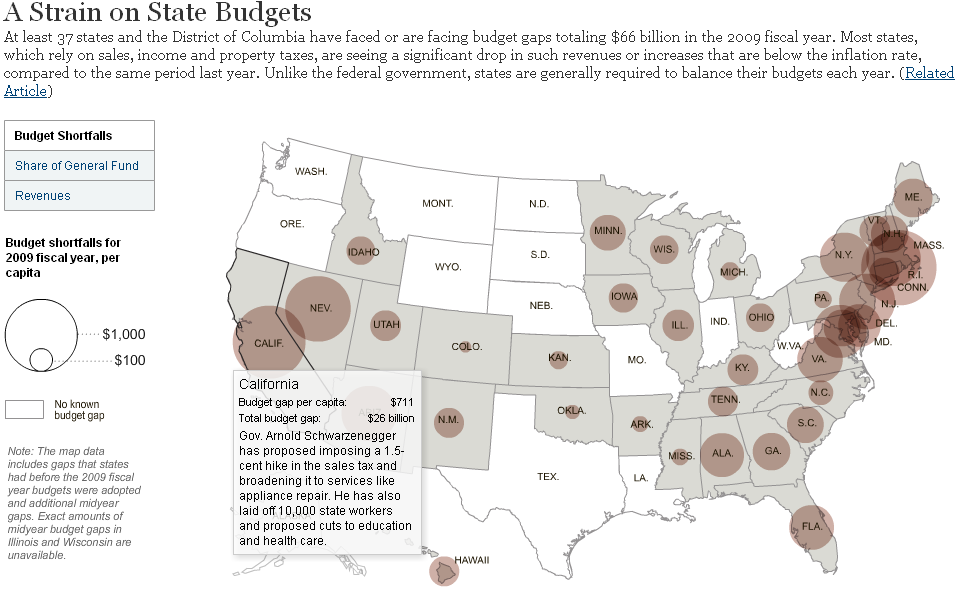Syndicated
Pick our fights and move to the states
My central insight in my recent disagreement with Patrick is that the creativity will take place in the states. While there will be some very important fights in Washington over the next 2-4 years, in particular health care, card check, and bailouts, another equally important fight will happen in 40 or more states over that time period. In the federal fights, our answer is likely to be simply: NO.
But at the states, something else will happen. Check out this map (click for a larger version), courtesy of the New York Times, via The Big Picture:
Our states — and our municipalities — are in fiscal crisis. They have gotten drunk on revenue from a credit bubble. As the economy deleverages to something sane, state and local revenue is, or has already, collapsed. Education budgets based on property taxes will develop massive holes when assessments reflect 40% drops in housing prices. Examples, from the NYT story above, of how bad it is:
In Michigan, to reduce overtime costs, fewer streets will be salted this winter. In Ohio, where the unemployment rate is above 7 percent, the state may need a federal loan for the first time in 26 years to cover unemployment costs. In Nevada, which is almost totally dependent on sales taxes and gamblingrevenues, a health administrator said the state may be unable to pay claims in a few months.
So we are going to need to cut spending and/or raise taxes to pay for some of these services. We are probably going to end up fighting over taxes. I searched Google News for "state tax increases" and came up with the following headlines from the last 24 hours:
- Milwaukee, WI: Most state residents don’t favor business tax increases, poll finds
- Alexandria, MN: Local proposed tax levies higher than state average
- North Mankato, MN: Tax increases for North Mankato
- Johnson County, KS: Readers write about Johnson County tax increases
- Utah: Utah gas tax increase in the pipeline?
- Florida: Budget blues lead lawmakers to eye raising cigarrette taxes
- Cortlandt, NY: Cortlandt cuts costs to reduce tax increases
- Phoenix, AZ: State’s drop in tax collections spurs concerns
- Kingston, NH: Kingston residents suprised over property tax hike
- Stafford, NH: Stafford tax rate to increase 76 cents
And, of course, the government employees unions, with their unsustainable pensions on the model of GM and Ford, are shaking the cup for their local and state tax increases too, as I have pointed out before.
There are opportunities here for Republicans to fix the brand. We can demand no tax increases. Perhaps more importantly, we can demand cost-saving reforms in government services. The leaders and winners of these fights will be the ones who will have earned their place as party leaders in the future.
Once again, the salvation for our party and our future leaders don’t reside in Washington. The real action will be in the state capitals. Outside of stopping some bailouts, the real action will reside there.
So let’s stop talking about Washington and figure out how to play in these states, state by state, municipality by municipality.
